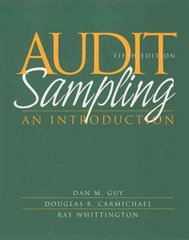Question
Question 1: Part A: The Commando Motorcycle Company has decided to become decentralized and split its operations into two divisions, Motor and Assembly. Both divisions
Question 1: Part A: The Commando Motorcycle Company has decided to become decentralized and split its operations into two divisions, Motor and Assembly. Both divisions will be treated as investment centers. The Motor Division is currently operating at its capacity of 30,000 motors per year. Motor's costs at this level of production are as follows: Cost per motor Direct materials $ 42 Direct labor 62 Variable manufacturing overhead 32 Fixed manufacturing overhead 37 Variable selling and administrative 17 Fixed selling and administrative 22 Total cost per motor $212 Motor sells 10,000 of its motors to a snowmobile manufacturer and transfers the remaining 20,000 motors to the Assembly Division. The two divisions are currently in a debate over an appropriate transfer price to charge for the 20,000 motors. Motor currently charges the snowmobile manufacturer $305 per motor. The final selling price of the motorcycles that Commando produces is $10,980 per cycle. This selling price will not change regardless of the transfer price charged between the two divisions. Motor has no market for the 20,000 motors if they are not transferred to Assembly. Variable selling and administrative costs are incurred on both internal and external sales. According to the formula in the text, what is the lowest acceptable transfer price from the viewpoint of the selling division? $59 per motor $212 per motor $173 per motor $153 per motor Part B: Division A makes a part with the following characteristics: Production capacity in units 15,600 units Selling price to outside customers $31 Variable cost per unit $22 Total fixed costs $60,600 Division B, another division of the same company, would like to purchase 5,600 units of the part each period from Division A. Division B is now purchasing these parts from an outside supplier at a price of $28 each. Suppose that Division A has ample idle capacity to handle all of Division B's needs without any increase in fixed costs and without cutting into sales to outside customers. If Division B continues to purchase parts from an outside supplier rather than from Division A, the company as a whole will be: rev: 02-12-2011 worse off by $33,600 each period. worse off by $50,400 each period. worse off by $30,000 each period. better off by $46,800 each period. 
Step by Step Solution
There are 3 Steps involved in it
Step: 1

Get Instant Access to Expert-Tailored Solutions
See step-by-step solutions with expert insights and AI powered tools for academic success
Step: 2

Step: 3

Ace Your Homework with AI
Get the answers you need in no time with our AI-driven, step-by-step assistance
Get Started


